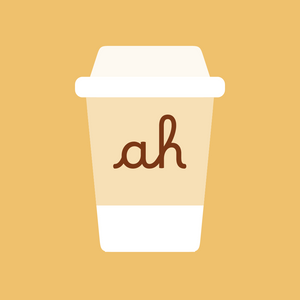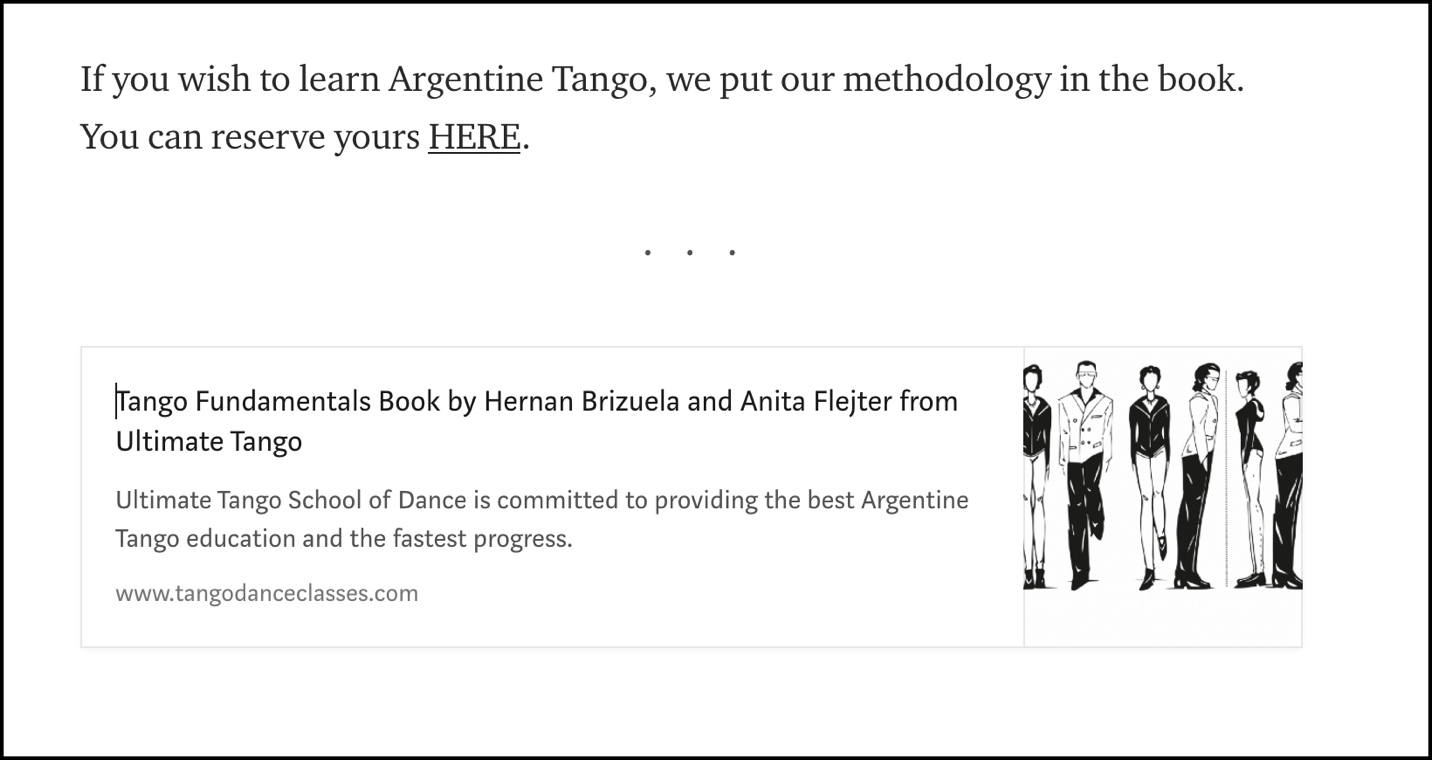When it comes to discussing or learning about basic tango steps, one is bound to encounter the ocho.
The ocho, or the figure eight, is always described as one of the fundamental figures of tango dancing.
Many instructors and lessons would reference it. In fact, the ocho or the figure eight is perhaps one of the earliest figures to be taught to beginners.
But what exactly is the tango ocho?

The Ocho Defined
“Ocho” is a Spanish term for the number eight. Most, if not all, names given to tango steps and movements basically describe what that specific step or move is all about. In this case, the ocho pertains to creating a figure eight while dancing.
However, it is quite interesting to note that while the tango ocho is regarded as a fundamental move in tango, it was not initially used by those who danced tango in Buenos Aires.
In the early years of tango, it appears that the ocho as a figure of tango was used by dancers outside of Buenos Aires, particularly those from the Northern Hemisphere.
A post from Library of Dance provides an interesting background:
“In El Tango Argentino, Lima describes one style of El Ocho (cross, side, close), with two possible timings (SQQ and SSS). Regarding its popularity,
Lima writes that El Ocho is a very beautiful figure, but that it is rarely used in Buenos Aires, either because the dancers don't know the figure, or they don't want to dance it.
“In the Northern Hemisphere, El Ocho appears to have exploded in popularity, with at least one version of it appearing in almost every major description of the Tango. In addition, in the North, there were many different variations of El Ocho. Without a time machine, we can't be sure exactly what happened, but it appears that in this case, the Northern tangueros decided to get creative, inventing new versions of this classic step.”
While it can seem that the ocho is a very simple move, at least in theory, it may actually be one of the hardest to master. This can be especially true for beginners. One way that might help in understanding the ocho is to first go back to its terminology. Tango Argentino de Tejas provides a list of terms related to the ocho, a summary of which can be found below:
● Ocho: Eight or figure eight. This figure involves crossing and pivoting. It is executed as a walking step with flexed knees and feet together while pivoting. Ochos can be danced either forward or backward, the direction of which relies on the follower’s perspective.
Along with the caminada or the walking steps, the El Ocho is considered as one of the oldest steps in tango.
One can trace the step back from the era when women still wore floor-length skirts with full petticoats. Since their footwork cannot be directly observed because their feet are being covered, the quality of their dance was judged by the figure they left behind on the dirt dance floors.
● Ocho Adelante: Ocho forward or front ocho.
● Ocho Atras: Ocho backward or back ocho.
● Ocho Cortado: Cut figure eight. The movement is done on either foot, pivoting backward or forward, either going left or right. It is basically a change in direction. Tanguito explains that this change of direction happens when the ocho is interrupted halfway through and the follower only draws half an eight.
No one knows exactly who invented the ocho cortado, but it is believed that a milonguero did it out of necessity.
According to the story, this milonguero began to lead an ocho but realized that he and his partner did not have enough space to finish it, thereby interrupting the move halfway. The ocho cortado is often used by dancers on crowded dance floors, such as in milongas. Thus, the ocho cortado is considered one of the most typical steps of a tango milonguero.
● Ochos en Espejo: Ochos in the mirror. Both the leader and follower simultaneously execute either a back ocho or a forward ocho, mirroring each other’s movements.
For beginners who want to learn how to perform the ocho, this video from Howcast provides an easy-to-follow tutorial on the basic eight-step figure, which can give one an initial idea of how the ocho works. This can be a useful point of reference before one attends tango classes or practicas.
The Infinite Ocho
Speaking of the number eight, it is not at all unusual for the tango ocho to also be associated with the infinity symbol. As one may already know, the infinity symbol resembles a horizontal number eight. This figure often signifies endlessness or an endless connection — where one cannot distinguish where the figure begins or ends.
In both theory and practice, one must remember that tango is all about connection.
One cannot begin any step or movement without first connecting with one's partner through the embrace. Often, having a strong connection or a stable embrace is what can make the difference between a great tango experience and a terrible one.
In terms of the ocho, it is possible to execute this figure an infinite number of times. While it is not necessary to do so, the possibility provides, quite literally, endless opportunities that one may apply this figure while dancing.
But how is this possible?
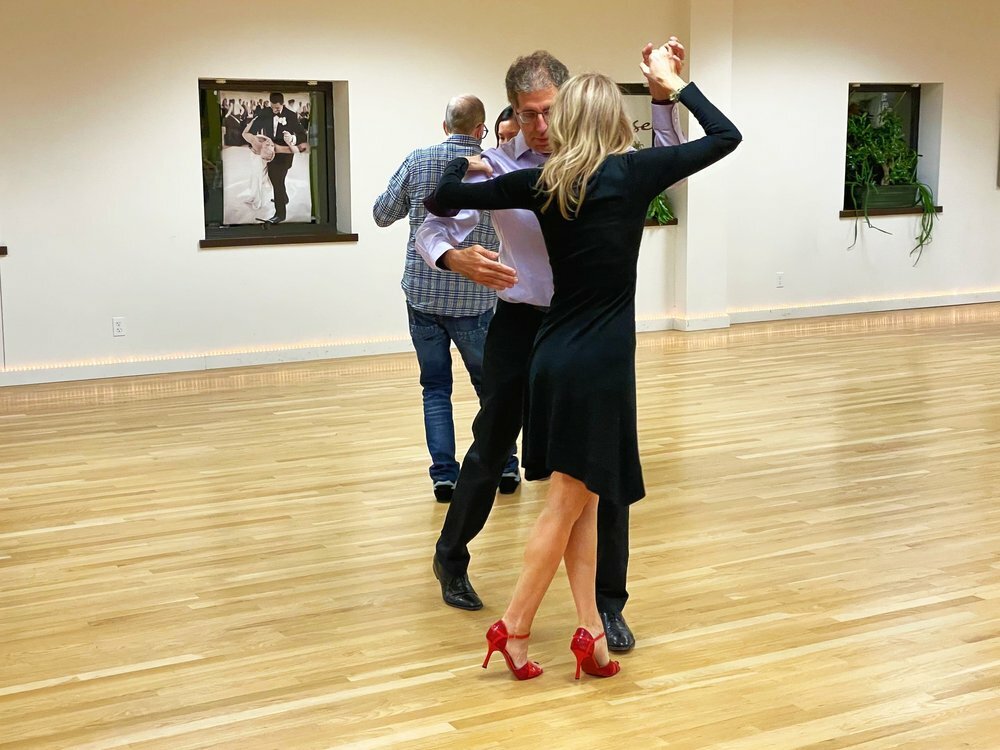
Tango Centurion provides an explanation:
“[The tango ocho] is associated with [infinity as]... It is a movement that combines your walk with your pivot, where you can see the woman’s body showing off her femininity by achieving that spiral shape. Specifically, to complete one tango ‘ocho’ you will do two walks with a pivot in the middle to join the two steps.
“It is super feminine and elegant in its anatomical shape.”
“But watch out! It also applies to the leader — it is not exclusive to the followers. We all walk and pivot.”
“The milonguero also performs this beautiful twisted movement, dissociated or whatever you want to call it.”
“In this infinite step, the expression, energy, and emotion of each interpreter shines. Ceasing to be just a simple ‘ocho’ step and giving it the spotlight and tribute it deserves.
“It is a movement that if you do it continuously, has no end, therefore infinite.
“[...] If you practice the [forward ocho and back ocho] in a straight imaginary line, you will feel that by connecting the parts of the walk with the pivot, you are drawing an eight, and then with the continuous movement you will achieve that moment of infinity.”
The infinite ocho being described here isn’t achieved through any fancy ocho that’s new to tango. In fact, it is referencing the traveling ocho. Tango Topics describes the traveling ocho as one of the most common ochos and is perhaps the “first and only ocho most people learn.” What makes the traveling ocho distinct is that, as its name suggests, it travels or moves down the line of dance.
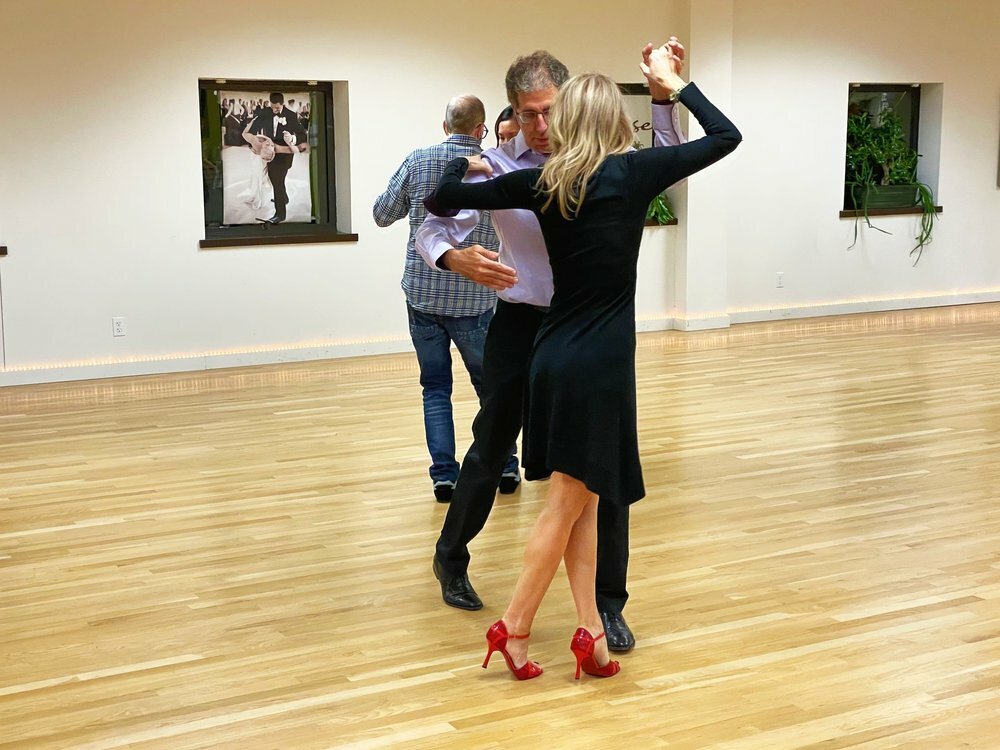
Sequences and Steps Possible With Ochos
The tango ocho as a theoretically infinite move opens up many possibilities for sequences and steps that can be done by applying this fundamental figure.
For instance, by performing the forward ocho and back ocho, one may create alternative sequences that one can use to make their tango dancing more playful, elegant, or diverse. There are various ways one can achieve this. Exploring Tango provides six possible alternative sequences. According to the post:
“Creating alternative ocho sequences is more about varying the steps of the other partner than varying the ochos themselves. The amount of pivot in the ochos might vary, but otherwise the sequence stays intact. [...]”
“Let's consider some possibilities for the leader while the follower performs ochos. Again, the roles can be reversed once we understand the structure of the combinations.
Repeating open side steps, as in the Common Ocho
Alternating forward and back cross steps with no pivots (changes of direction) in between
Simultaneous forward or backward ochos
Complex steps, e.g. forward cross steps alternating with open side steps
Rhythmic complexity, e.g. taking two steps for every one of the follower
Stationary lead, i.e. leading with the upper body only while standing in one place”
At the same time, there are other steps common to Argentine tango that can be performed in combination with or result from the ocho. In fact, even adornos or embellishments may be performed during ochos. Here are some examples of steps and embellishments, with descriptions based on the post by Tango Argentino de Tejas:
● Molinete: Derived from the Spanish term for windmill or wheel. This uses the forward and back ocho technique and footwork as the follower dances a grapevine around the leader.
● Parada: From the term “parar” or “to stop.” The leader stops the follower, typically when she cross steps back from a back ocho or molinete. The leader exerts subtle pressure inward on the follower’s back and at her balance hand. The movement is prevented by a slight downward thrust.
● Salida de Gato: This is a variation on the basico in which the leader performs a series of steps that culminates in a lead for a follower’s forward ocho. This figure enters ochos without using the cruzada.
● Sacada: The most common term applied to instances when one partner’s leg or foot is displaced by the other partner’s leg or foot. Sacada occurs when a dancer places their foot or leg against their partner’s, transferring weight to their leg, so it moves into the space of and displaces the partner’s leg.
● Pasada: “Passing over.” Often used at the end of a molinete or mordida, this occurs when the leader extends their foot to stop the follower, leading the latter to step over the extended foot.
● Sandwich or Sanguchito: Also called mordida, meaning to bite. One partner’s foot is trapped or “sandwiched” between the other partner’s feet.
● Castigada: Taken from the Spanish word meaning “to punish.” This is an embellishment often done by a follower prior to stepping forward during a parada or ocho. Here, the follower lifts their working leg, followed by a flexing at the knee and caressing the working foot down the outside of the supporting leg.
● Cucharita: “The spoon.” Another embellishment wherein the follower’s leg is lifted by a gentle scooping motion done by the leader’s foot upon the follower’s shoe. This flicking motion is often led during forward ochos.
● Picados: An advanced embellishment usually done during ochos or when walking forward. This involves flicking the heel upward when turning or stepping forward.
These are just some examples about what can be done by performing an ocho. It is important to note, however, that these and many other sequences and steps are possible to combine with ochos when one knows how to change direction during ochos.
This video from Tango Space provides a short but important list of things to remember when attempting to change the direction of ochos:
Change the direction of the ochos only when the follower is on their axis.
Play with the change of directions as long as they are in the axis.
One must be precise with the pivot. Make sure the follower is on one leg before changing the direction of the ocho.
For followers, make sure not to anticipate the leader's steps. This is also called back leading. Do not pivot before the leader suggests the move.
Always stay connected with the direction of the leader.
Changing the direction of ochos through a giro or turn is also possible, though it may be a bit more difficult. However, it may be easier when one is familiar with Gustavo Naveira’s concept of Nuevo Tango. This, as described by Huffpost,
“features a very inventive manner of doing tango, in which dancers will move from a steady axis of balance to a quite off-balance mode that requires different thinking than that in so-called traditional tango.”
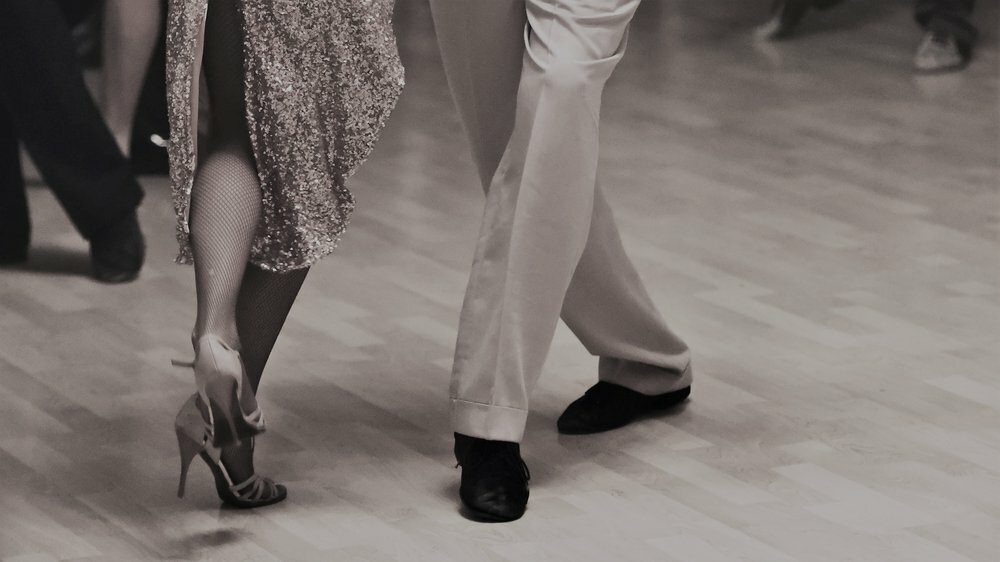
The Endless Loop of Rhythm
The ocho may be a fundamental tango step, but it is also a rather broad topic that crosses with other tango-related discussions.
What may be crucial to remember about this step is that while it can seem confusing or even intimidating at first, especially when applied outside of theory or technique, constant practice is what can eventually lead to a more natural execution.
Keep practicing the ocho and its different directions and, soon enough, one would find oneself more comfortable with this figure.
If you wish to learn Argentine Tango, we put our methodology in the book. You can reserve yours HERE.
